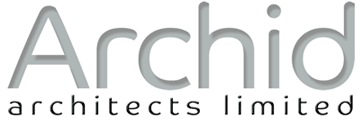
Practice : Environment
Environmental Policy
Archid Architects are keen to promote sustainable low energy design and have recently completed a new build ‘passive house.’ Climate change is happening and while the reasons are debatable, fossil fuel reserves are limited, fuel costs are rising fast and oil based material resources are limited. This makes it sensible on a purely pragmatic level to reduce heat loss and energy usage in the construction and operation of our built environment.
We try with every project undertaken to save energy in use and minimise its impact on the environment. We have researched and utilised various systems and technologies with the aim of minimising embodied energy, reducing heat loss, energy use and where practical we use materials from local, sustainable sources. We do, however, have a pragmatic approach and work to our clients’ agenda rather than being overly pushy in promoting our own. Among the materials and syetems used in past projects are:
- The ‘Thermoplan block system’ from NBT, an extruded breathable clay block
- High performance breathable timber frame systems and wood fibre, hemp/cotton and recycled newspaper insulation
- Proclima Intello inetlligent vapour control layer and associated Tescon tapes to achive air tightness and vapour permiability
Using these construction methods to exceed mandatory U-values we have found that the costs acceptable when balanced against improved performance and comfort.
Archid believe strongly in ‘passive’ environmental technologies that are ‘built in’ to our designs. This is sometimes now referred to as the 'fabric first' approach. Balancing orientation, solar gain, thermal mass, ventilation and insulation are the basic tools for creating comfortable environments for building users. We believe that considering these basics early in the development of a project is vital and can reduce the amount of heating, electric lighting etc. required on any given job.
We are also realists when it comes to utilising environmental technology and accept that clients have differing priorities when it comes to building. There is often an opportunity to improve a project's sustainability credentials even on the most cost driven projects and we endeavour to incorporate improvements where possible.
Passive House:
Having recently designed an earth sheltered house to ‘Passive House’ standards, we are believers in the standard and in the use of the passive house planning package (PHPP) spreadsheet as a design tool. Passive House is a rigorous, voluntary standard for energy efficiency in building that results in buildings that require very little energy for heating and cooling.
Passive houses are required to fulfill the following requirements:
- an annual heating demand as calculated with the Passivhaus Planning Package of not more than 15 kWh/m² per year in heating OR to be designed with a peak heat load of 10W/m²
- total primary energy and consumption (energy for heating, hot water, lighting and small power) must not be more than 120 kWh/m² per year
- the building must not leak more air than 0.6 times the house volume per hour at 50 Pa as tested by a blower door
To achieve this super insulation, triple glazing and mechanical ventilation with heat recovery (MVHR) are required as well as very careful consideration of detailing for ‘air tightness.’ We are Certified European Passive House Designers and confident PHPP (passive house planning package) users. We are also confident in the use of THERM to calculate 2D thermal bridging and can offer this as a service to others.
Renewable Technologies:
These also have a key role to play in a sustainable future. Having specified and researched various solutions personally and for clients, Archid Architects have a good grasp on appropriate technology to any given project. Knowing what is likely to be cost effective, work best and what is likely to recieve funding support from government are vital considerations when looking at new build or improvement of existing buildings. Keen to reduce his gas bill, Peter (director) has recently installed an automated biomass pellet boiler and solar water panels at his inefficient 110 year old house and is so far very impressed with the savings. We have also installed heat pumps and researched wind turbines and photo voltaics for clients.
